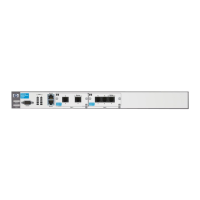6-45
Configuring the Data Link Layer Protocol for E1, T1, and Serial Interfaces
Configuring the Logical Interface
For example, if you want to bind the T1 2/1 interface to the HDLC 1 interface,
enter:
ProCurve(config)# bind 1 t1 2/1 hdlc 1
If you want to bind the serial interface to the HDLC interface, enter:
ProCurve(config)# bind 1 serial 1/1 hdlc 1
Note If you are binding a serial interface to the HDLC interface, you do not include
the TDM group number because you do not use TDM groups on a serial
interface.
Additional Settings
Depending on your company’s WAN environment, you may want to configure
other options on the HDLC interface.
Configure a Secondary IP Address for the Interface. You can config-
ure a secondary IP address on the HDLC interface. From the HDLC interface
configuration mode context, enter:
Syntax: ip address <A.B.C.D> <subnet mask | /prefix length> secondary
Replace <A.B.C.D> with secondary IP address and specify a subnet mask
using the <subnet mask> option or the </prefix length> option. Finally,
include the secondary option.
For example, you might enter:
ProCurve(config-hdlc 1)# ip address 192.168.5.1 255.255.255.252 secondary
You can include an unlimited number of secondary IP addresses.
To remove the secondary IP address, enter:
Syntax: no ip address <A.B.C.D> <subnet mask | /prefix length> secondary
Set the MTU. The MTU defines the largest size that a frame can be. If a frame
exceeds the size limit, it must be fragmented. For best results, the MTU size
on the HDLC interface should match the MTU used by the remote router.

